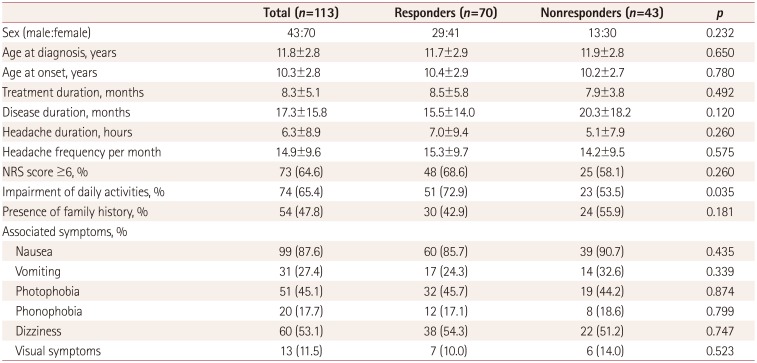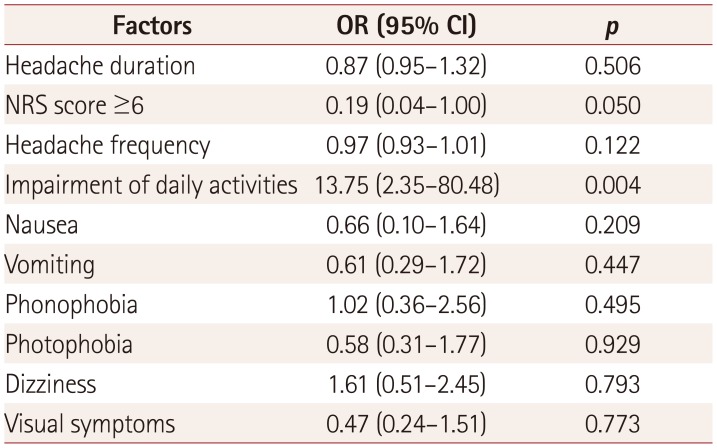1. Bille BS. Migraine in school children. A study of the incidence and short-term prognosis, and a clinical, psychological and electroencephalographic comparison between children with migraine and matched controls. Acta Paediatr Suppl. 1962; 136:1–151. PMID:
13869189.
2. Hershey AD. Pediatric headache: update on recent research. Headache. 2012; 52:327–332. PMID:
22288386.

3. Lewis DW. Pediatric migraine. Neurol Clin. 2009; 27:481–501. PMID:
19289227.

4. Abu-Arefeh I, Russell G. Prevalence of headache and migraine in schoolchildren. BMJ. 1994; 309:765–769. PMID:
7950559.

5. Rho YI, Chung HJ, Lee KH, Eun BL, Eun SH, Nam SO, et al. Prevalence and clinical characteristics of primary headaches among school children in South Korea: a nationwide survey. Headache. 2012; 52:592–599. PMID:
21929660.

6. Stang PE, Osterhaus JT. Impact of migraine in the United States: data from the National Health Interview Survey. Headache. 1993; 33:29–35. PMID:
8436495.

7. Wasiewski WW. Preventive therapy in pediatric migraine. J Child Neurol. 2001; 16:71–78. PMID:
11292228.

8. Bidabadi E, Mashouf M. A randomized trial of propranolol versus sodium valproate for the prophylaxis of migraine in pediatric patients. Paediatr Drugs. 2010; 12:269–275. PMID:
20593910.

9. Hershey AD, Powers SW, Bentti AL, Degrauw TJ. Effectiveness of amitriptyline in the prophylactic management of childhood headaches. Headache. 2000; 40:539–549. PMID:
10940092.

10. Kim H, Byun SH, Kim JS, Lim BC, Chae JH, Choi J, et al. Comparison of flunarizine and topiramate for the prophylaxis of pediatric migraines. Eur J Paediatr Neurol. 2013; 17:45–49. PMID:
23111149.

11. Serdaroglu G, Erhan E, Tekgul H, Oksel F, Erermis S, Uyar M, et al. Sodium valproate prophylaxis in childhood migraine. Headache. 2002; 42:819–822. PMID:
12390647.

12. Winner P, Pearlman EM, Linder SL, Jordan DM, Fisher AC, Hulihan J. Topiramate Pediatric Migraine Study Investigators. Topiramate for migraine prevention in children: a randomized, double-blind, placebo-controlled trial. Headache. 2005; 45:1304–1312. PMID:
16324162.

13. Lewis D, Winner P, Saper J, Ness S, Polverejan E, Wang S, et al. Randomized, double-blind, placebo-controlled study to evaluate the efficacy and safety of topiramate for migraine prevention in pediatric subjects 12 to 17 years of age. Pediatrics. 2009; 123:924–934. PMID:
19255022.

14. Sorge F, De Simone R, Marano E, Nolano M, Orefice G, Carrieri P. Flunarizine in prophylaxis of childhood migraine. A double-blind, placebo-controlled, crossover study. Cephalalgia. 1988; 8:1–6.

15. Headache Classification Subcommittee of the International Headache Society (IHS). The International Classification of Headache Disorders, 2nd ed. Cephalalgia. 2004; 24(suppl 1):9–160. PMID:
14979299.
16. Hershey AD. Pediatric headache. Continuum (Minneap Minn). 2015; 21:1132–1145. PMID:
26252596.

17. Pringsheim T, Davenport W, Mackie G, Worthington I, Aubé M, Christie SN, et al. Canadian Headache Society guideline for migraine prophylaxis. Can J Neurol Sci. 2012; 39(2 Suppl 2):S1–S59.
18. Silberstein SD. Preventive migraine treatment. Continuum (Minneap Minn). 2015; 21:973–989. PMID:
26252585.

19. Lucetti C, Nuti A, Pavese N, Gambaccini G, Rossi G, Bonuccelli U. Flunarizine in migraine prophylaxis: predictive factors for a positive response. Cephalalgia. 1998; 18:349–352. PMID:
9731940.

20. Rossi P, Fiermonte G, Pierelli F. Cinnarizine in migraine prophylaxis: efficacy, tolerability and predictive factors for therapeutic responsiveness. An open-label pilot trial. Funct Neurol. 2003; 18:155–159. PMID:
14703897.
21. Wöber C, Wöber-Bingöl C, Koch G, Wessely P. Long-term results of migraine prophylaxis with flunarizine and beta-blockers. Cephalalgia. 1991; 11:251–256. PMID:
1790569.

22. Lampl C, Huber G, Adl J, Luthringshausen G, Franz G, Marecek S, et al. Two different doses of amitriptyline ER in the prophylaxis of migraine: long-term results and predictive factors. Eur J Neurol. 2009; 16:943–948. PMID:
19456855.

23. Yang CP, Chang MH, Li TC, Hsieh CL, Hwang KL, Chang HH. Predicting prognostic factors in a randomized controlled trial of acupuncture versus topiramate treatment in patients with chronic migraine. Clin J Pain. 2013; 29:982–987. PMID:
23370087.

24. Amery WK, Caers LI, Aerts TJ. Flunarizine, a calcium entry blocker in migraine prophylaxis. Headache. 1985; 25:249–254. PMID:
3897128.

25. Raieli V, Pitino R, Giordano G, Spitalieri C, Consolo F, Puma D, et al. Migraine in a pediatric population: a clinical study in children younger than 7 years of age. Dev Med Child Neurol. 2015; 57:585–588. PMID:
25586426.
26. Virtanen R, Aromaa M, Rautava P, Metsähonkala L, Anttila P, Helenius H, et al. Changing headache from preschool age to puberty. A controlled study. Cephalalgia. 2007; 27:294–303. PMID:
17376106.

27. Eidlitz-Markus T, Gorali O, Haimi-Cohen Y, Zeharia A. Symptoms of migraine in the paediatric population by age group. Cephalalgia. 2008; 28:1259–1263. PMID:
18727643.
28. Bisdorff A, Andrée C, Vaillant M, Sándor PS. Headache-associated dizziness in a headache population: prevalence and impact. Cephalalgia. 2010; 30:815–820. PMID:
20647172.

29. Vuković V, Plavec D, Galinović I, Lovrencić-Huzjan A, Budisić M, Demarin V. Prevalence of vertigo, dizziness, and migrainous vertigo in patients with migraine. Headache. 2007; 47:1427–1435. PMID:
18052952.

30. Noseda R, Burstein R. Migraine pathophysiology: anatomy of the trigeminovascular pathway and associated neurological symptoms, CSD, sensitization and modulation of pain. Pain. 2013; 154(Suppl 1):
31. Silberstein SD. Migraine symptoms: results of a survey of self-reported migraineurs. Headache. 1995; 35:387–396. PMID:
7672955.

32. Kelman L. The premonitory symptoms (prodrome): a tertiary care study of 893 migraineurs. Headache. 2004; 44:865–872. PMID:
15447695.

33. Lipton RB, Stewart WF, Diamond S, Diamond ML, Reed M. Prevalence and burden of migraine in the United States: data from the American Migraine Study II. Headache. 2001; 41:646–657. PMID:
11554952.

34. Anda R, Tietjen G, Schulman E, Felitti V, Croft J. Adverse childhood experiences and frequent headaches in adults. Headache. 2010; 50:1473–1481. PMID:
20958295.

35. Milde-Busch A, Blaschek A, Heinen F, Borggräfe I, Koerte I, Straube A, et al. Associations between stress and migraine and tension-type headache: results from a school-based study in adolescents from grammar schools in Germany. Cephalalgia. 2011; 31:774–785. PMID:
21233282.

36. Schankin CJ, Rémi J, Klaus I, Sostak P, Reinisch VM, Noachtar S, et al. Headache in juvenile myoclonic epilepsy. J Headache Pain. 2011; 12:227–233. PMID:
21437711.

37. Tietjen GE, Peterlin BL. Childhood abuse and migraine: epidemiology, sex differences, and potential mechanisms. Headache. 2011; 51:869–879. PMID:
21631473.

38. Toldo I, Perissinotto E, Menegazzo F, Boniver C, Sartori S, Salviati L, et al. Comorbidity between headache and epilepsy in a pediatric headache center. J Headache Pain. 2010; 11:235–240. PMID:
20112041.







 PDF
PDF ePub
ePub Citation
Citation Print
Print



 XML Download
XML Download